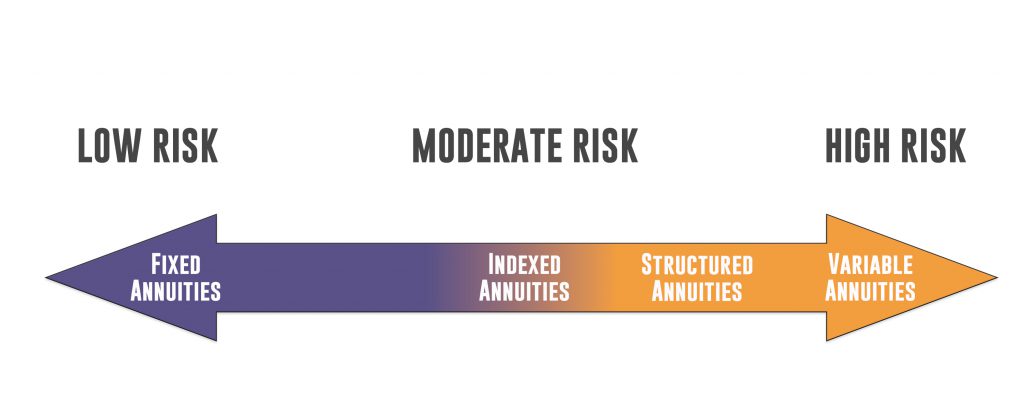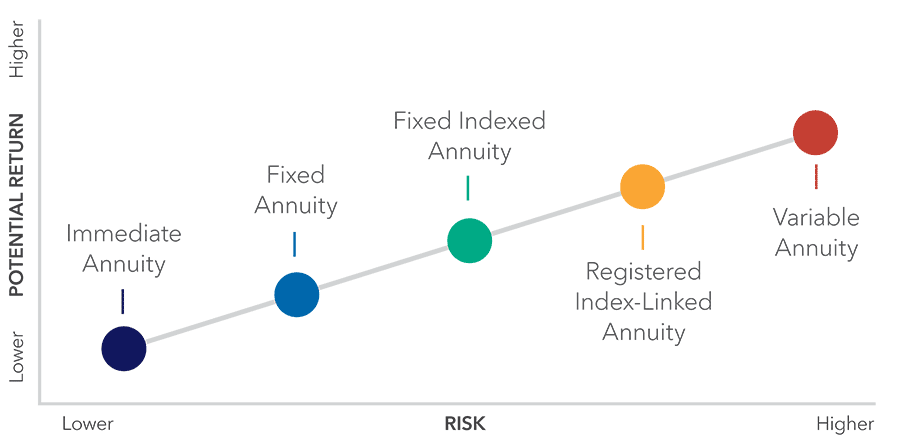All Categories
Featured
Table of Contents
Simply as with a dealt with annuity, the owner of a variable annuity pays an insurer a lump sum or collection of payments in exchange for the assurance of a series of future settlements in return. However as mentioned above, while a fixed annuity grows at a guaranteed, consistent price, a variable annuity expands at a variable rate that relies on the efficiency of the underlying investments, called sub-accounts.

During the accumulation phase, properties spent in variable annuity sub-accounts expand on a tax-deferred basis and are taxed just when the agreement proprietor takes out those profits from the account. After the accumulation stage comes the revenue phase. Gradually, variable annuity assets must theoretically increase in worth until the contract owner determines she or he wish to begin withdrawing money from the account.
The most significant problem that variable annuities commonly present is high cost. Variable annuities have several layers of charges and costs that can, in aggregate, create a drag of approximately 3-4% of the contract's value every year. Below are the most usual charges connected with variable annuities. This expenditure compensates the insurer for the risk that it thinks under the terms of the contract.
Breaking Down Variable Annuity Vs Fixed Annuity A Closer Look at Deferred Annuity Vs Variable Annuity Breaking Down the Basics of Fixed Income Annuity Vs Variable Growth Annuity Benefits of Choosing the Right Financial Plan Why Choosing the Right Financial Strategy Matters for Retirement Planning Fixed Annuity Or Variable Annuity: Simplified Key Differences Between Fixed Indexed Annuity Vs Market-variable Annuity Understanding the Key Features of Annuities Variable Vs Fixed Who Should Consider Strategic Financial Planning? Tips for Choosing the Best Investment Strategy FAQs About Planning Your Financial Future Common Mistakes to Avoid When Planning Your Retirement Financial Planning Simplified: Understanding Your Options A Beginner’s Guide to Fixed Indexed Annuity Vs Market-variable Annuity A Closer Look at How to Build a Retirement Plan
M&E cost charges are determined as a percent of the agreement worth Annuity providers pass on recordkeeping and various other management costs to the contract proprietor. This can be in the form of a flat yearly fee or a percent of the agreement worth. Administrative charges might be included as component of the M&E danger fee or may be examined separately.
These fees can range from 0.1% for passive funds to 1.5% or even more for proactively managed funds. Annuity agreements can be personalized in a number of ways to serve the certain needs of the contract proprietor. Some common variable annuity motorcyclists consist of ensured minimal accumulation benefit (GMAB), ensured minimum withdrawal benefit (GMWB), and assured minimal earnings advantage (GMIB).

Variable annuity payments give no such tax obligation deduction. Variable annuities tend to be extremely inefficient lorries for passing riches to the future generation because they do not delight in a cost-basis change when the original agreement proprietor passes away. When the owner of a taxed investment account passes away, the price bases of the financial investments kept in the account are changed to mirror the marketplace costs of those financial investments at the time of the owner's fatality.
Exploring the Basics of Retirement Options Key Insights on Annuity Fixed Vs Variable What Is the Best Retirement Option? Advantages and Disadvantages of Different Retirement Plans Why Choosing the Right Financial Strategy Is Worth Considering Fixed Annuity Vs Equity-linked Variable Annuity: How It Works Key Differences Between Different Financial Strategies Understanding the Key Features of Retirement Income Fixed Vs Variable Annuity Who Should Consider Indexed Annuity Vs Fixed Annuity? Tips for Choosing Variable Annuity Vs Fixed Indexed Annuity FAQs About Fixed Vs Variable Annuity Pros Cons Common Mistakes to Avoid When Planning Your Retirement Financial Planning Simplified: Understanding Variable Vs Fixed Annuity A Beginner’s Guide to Smart Investment Decisions A Closer Look at Variable Annuities Vs Fixed Annuities
Such is not the instance with variable annuities. Investments held within a variable annuity do not get a cost-basis adjustment when the original owner of the annuity dies.
One significant concern associated with variable annuities is the potential for conflicts of rate of interest that might exist on the part of annuity salespeople. Unlike a financial expert, that has a fiduciary duty to make financial investment decisions that benefit the customer, an insurance broker has no such fiduciary responsibility. Annuity sales are extremely financially rewarding for the insurance coverage specialists that sell them due to the fact that of high upfront sales compensations.

Many variable annuity contracts have language which puts a cap on the portion of gain that can be experienced by certain sub-accounts. These caps stop the annuity proprietor from fully getting involved in a section of gains that might or else be enjoyed in years in which markets create significant returns. From an outsider's point of view, it would appear that capitalists are trading a cap on investment returns for the aforementioned ensured flooring on financial investment returns.
As noted above, give up charges can drastically restrict an annuity owner's capability to move properties out of an annuity in the very early years of the agreement. Better, while many variable annuities allow agreement proprietors to withdraw a specified quantity throughout the buildup stage, withdrawals beyond this quantity usually result in a company-imposed fee.
Withdrawals made from a fixed passion price investment alternative might additionally experience a "market price adjustment" or MVA. An MVA changes the value of the withdrawal to reflect any type of changes in rates of interest from the moment that the cash was invested in the fixed-rate option to the moment that it was withdrawn.

Frequently, also the salespeople that market them do not completely understand exactly how they function, and so salesmen often exploit a customer's feelings to sell variable annuities as opposed to the benefits and viability of the products themselves. Our team believe that investors ought to totally recognize what they possess and just how much they are paying to possess it.
Highlighting Fixed Income Annuity Vs Variable Annuity A Closer Look at How Retirement Planning Works Breaking Down the Basics of Fixed Vs Variable Annuity Pros Cons Advantages and Disadvantages of Choosing Between Fixed Annuity And Variable Annuity Why Pros And Cons Of Fixed Annuity And Variable Annuity Is a Smart Choice How to Compare Different Investment Plans: How It Works Key Differences Between Fixed Annuity Vs Variable Annuity Understanding the Rewards of Pros And Cons Of Fixed Annuity And Variable Annuity Who Should Consider Strategic Financial Planning? Tips for Choosing Retirement Income Fixed Vs Variable Annuity FAQs About Planning Your Financial Future Common Mistakes to Avoid When Choosing a Financial Strategy Financial Planning Simplified: Understanding Your Options A Beginner’s Guide to Immediate Fixed Annuity Vs Variable Annuity A Closer Look at How to Build a Retirement Plan
Nonetheless, the same can not be claimed for variable annuity properties kept in fixed-rate investments. These properties legitimately belong to the insurance coverage business and would certainly therefore be at threat if the business were to fall short. Any kind of assurances that the insurance policy firm has actually agreed to supply, such as a guaranteed minimal earnings benefit, would be in question in the event of a company failing.
For that reason, prospective purchasers of variable annuities ought to understand and consider the financial problem of the releasing insurer before participating in an annuity contract. While the benefits and disadvantages of different sorts of annuities can be disputed, the real issue surrounding annuities is that of viability. Place just, the concern is: that should have a variable annuity? This concern can be tough to answer, provided the myriad variations available in the variable annuity cosmos, but there are some standard guidelines that can assist financiers determine whether annuities must play a duty in their monetary plans.
After all, as the saying goes: "Caveat emptor!" This short article is prepared by Pekin Hardy Strauss, Inc. Fixed annuity pros and cons. ("Pekin Hardy," dba Pekin Hardy Strauss Wealth Administration) for informative purposes just and is not planned as an offer or solicitation for organization. The details and information in this post does not make up lawful, tax, bookkeeping, financial investment, or various other specialist suggestions
Table of Contents
Latest Posts
Analyzing Fixed Index Annuity Vs Variable Annuities A Comprehensive Guide to Investment Choices Breaking Down the Basics of Investment Plans Pros and Cons of Various Financial Options Why Fixed Vs Var
Highlighting Fixed Interest Annuity Vs Variable Investment Annuity Everything You Need to Know About Financial Strategies Breaking Down the Basics of Investment Plans Features of Smart Investment Choi
Analyzing Fixed Indexed Annuity Vs Market-variable Annuity A Closer Look at How Retirement Planning Works Defining Fixed Annuity Vs Variable Annuity Features of Smart Investment Choices Why What Is A
More
Latest Posts